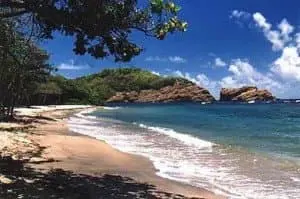Martinique
When Columbus landed in 1502, the island we now know as Martinique was peopled by the Carib Indians who called it Matinino or Madinina. The Caribs had driven away the Arawaks who, like themselves, had come to this Caribbean island from South America. The island was claimed by France in 1635 and officially annexed by the King of France in 1674. France and Britain fought over the island until 1815, when it was restored to France. An important date in Martinique’s history occurred 150 years ago on May 22, 1848, when slavery was abolished. In 1946, Martinique became a Department of France and in 1974 a Region of France.
Historical sites worth seeing include La Pagerie, where Napoléon’s Empress Joséphine was born in 1763 (the year that France relinquished rights to Canada in exchange for the French West Indies); St-Pierre, Martinique’s principal city until May 8, 1902 when Mt. Pelée volcano erupted, wiping out the city and its 30,000 people in just three minutes; and Diamond Rock, a 600-ft. pinnacle in the sea manned by the British in 1804 and registered in the British Navy as an armed warship for 18 months. Be sure you ask your captain on your chartered boat from Taylor’d Yacht Charters to cruise by Diamond Rock.
There are a dozen good nightspots with a zouk or jazz beat in Fort-de-France and out of town around the island. There are a number of piano bars and late night discos. Check the local newspaper, “France-Antilles”, for musical events and venues. Many hotels have dancing, as well as shows by Les Grands Ballets de la Martinique or Les Balisiers or Pom’ Cannelle, all fine troupes of talented dancers, singers, and musicians.


